Don’t have the time to read the entire article right now?
That’s Ok. Let us send you a copy so you can read it whenever you want to. Tell us where to send it.
Data cleaning has grown into a complex activity as data sources and types keep multiplying. With dirty data muddying data reliability, B2B data aggregators today are adopting new database cleaning strategies and automation to protect the quality, credibility, and saleability of their datasets.
Cleaning dirty data is a critical responsibility of B2B data aggregators, and its results directly affect their market credibility. Customers come to buy clean, standardized, organized and comprehensive datasets. And any presence of corrupt data makes those datasets unusable. Lack of diligence in data cleaning can make a data seller lose both reputation and customers.
The job is not easy. Data volumes are growing exponentially and forecasted to reach 572 Zettabytes by 2030, which is around 10 times more than the volumes today. To handle this tsunami of data, B2B data aggregators need to use advanced data cleansing solutions backed with tools, technology and automation. But to use modern tools effectively, they also need to have a holistic understanding of dirty data and data cleaning operations.
We have created this data cleaning guide to walk you through the fundamentals of data cleansing, explain why it’s needed, demonstrate the benefits and challenges and provide examples and a primer on how to clean data.
Table of Contents
Raw data from disparate sources comes in with missed values, format inconsistencies, duplicates, typos, and erroneous entries. Data decay is another major issue affecting datasets. And data cleaning must be done thoroughly before the datasets reach the hands of companies who’ll use the data for analysis and business decisions.
Data cleansing is the process used to identify and rectify all corrupt, inaccurate, irrelevant, incomplete, duplicate, and inconsistent data. It is a process where the database is made accurate and is also enriched with additional information. The process helps in data maintenance, improving data quality, and keeping data clean, accurate, up-to-date, and sellable. The job is best done by data specialists who are well-versed in different data cleansing techniques.

Data cleansing, data cleaning, and data scrubbing are mostly used interchangeably and often understood as the same thing. But going deeper into the terms, data scrubbing has a slightly different meaning. Data cleaning or data cleansing is the process where data experts monitor the database, identify problems, figure out solutions and implement data hygiene best practices.
Data scrubbing is a subset of data cleansing that uses tools and techniques for much deeper cleaning. It refers to a specific part of the data cleaning process, such as removing duplicates or corrupt data from the datasets.
Clean data is the key to effective marketing campaigns. Any inaccuracy in B2B data can lead to inaccurate customer metrics, misleading customer records, and incorrect market segmentation. These lead to missed opportunities, damaged relations, and finally revenue loss. Therefore, data cleaning is not a onetime process, but run regularly to check errors and data decay.
Data cleaning is extremely important for several reasons:
Data migration: Data migration is the process of moving data or files from one system to another. Being a high-risk activity, data cleansing forms an integral part of data migration. Data is validated and verified at the pre-migration and post-migration stages for quality, consistence, and usability.
Data integration: Combining data from diverse sources into a single view is called data integration. Data cleansing is crucial in this process as chances of errors like duplicates and incomplete or incorrectly formatted data can easily creep into the system. Data cleaning techniques ensure the data is free of errors and standardized before moving to the destination site.
Data transformation: Data transformation happens when data is converted to match the target or destination database. It is the process of converting data from one format or structure into another format or structure. Data extracted from diverse sources can have errors, meaningless data, or contradictory data and new errors may creep in during format conversion. Data cleaning helps remove these errors before and after structuring the data.
Data debugging in ETL processes: Data cleansing is extremely important while preparing data for the (ETL) ‘Extract, Transform, and Load’ process. This involves extracting data from multiple sources, then transforming and loading it in the target data warehouse. Data cleaning ensures the availability of only high-quality data for any business decision or analytics.
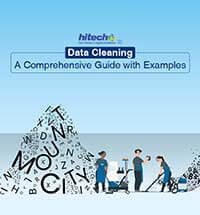
Don’t have the time to read the entire article right now?
That’s Ok. Let us send you a copy so you can read it whenever you want to. Tell us where to send it.
Data cleansing helps B2B data aggregators. These are some top benefits:
Need to fight loss in data accuracy?
Contact our experts to ensure credibility and increase revenue.
Duplicate data is any record that repeats the data in another record in the database. There could be an exact carbon copy of records, or it could be partial duplicates. Duplicate data makes your data dirty and can harm your business in multiple ways. The lack of a single customer view can lead to confusion among customers and missed sales opportunities.
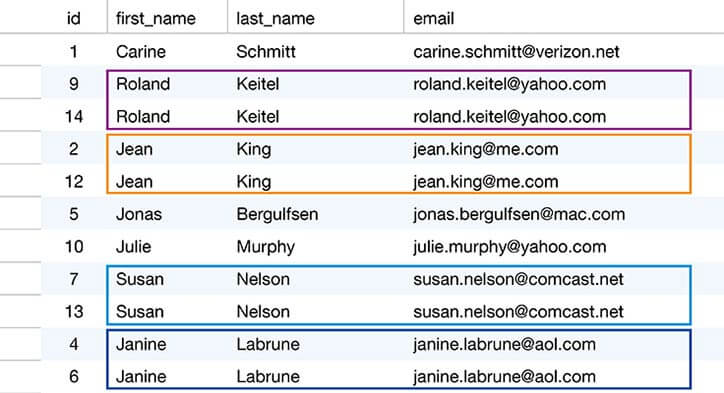
Example: There could be two records of the same person wherein one record has an email while the other a phone number. There could be a case where the customer has already subscribed to your newsletter and while transferring data from CRM, a duplicate record is created. Sometimes, when the same customer’s name is written in different ways, you create multiple records of the same person.
Solution: Arbitrarily removing duplicate records can lead to loss of data. The data has to be matched using advanced matching techniques. Invest in an automation platform that detects duplicates and cleans up data. Use a merge/purge process where records are merged, eliminating duplicates, and retaining all valuable information from all records.
Data decays at a quick pace. Old data that is no longer relevant handicaps decisions. People change jobs, companies merge, promotions happen, and emails and phone numbers change. All these, if not corrected, make your database outdated.
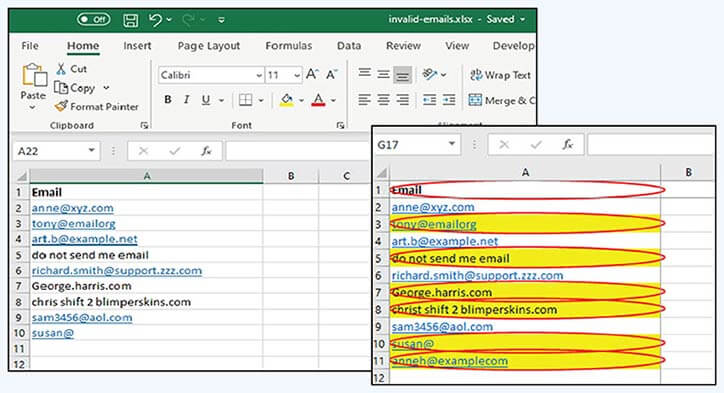
Example: When a customer moves to a different location or organization and the email address changes, or the person changes his or her mobile number. So, the records in your database become invalid.
Solution: Purge and cleanse data before migrating it or integrating into new systems. Use automated tools to keep updating old records. Constant real-time database updates are essential to keep the database current and address data decay issues. Scheduled macros and bots can constantly gather and change data. Automated scheduled crawlers can trigger alerts for any change in data wherein automatically old data is replaced with new and relevant data.
Information gaps where critical data or records are missing result in incomplete data in databases. Records with missing fields like phone number, email, industry name, job title, etc. impact the customer connection rates. Companies also look for additional data on customer preferences, demographics, attitudes, etc. for accurate and personalized targeting. Without a complete customer overview, a database is of limited utility to companies.
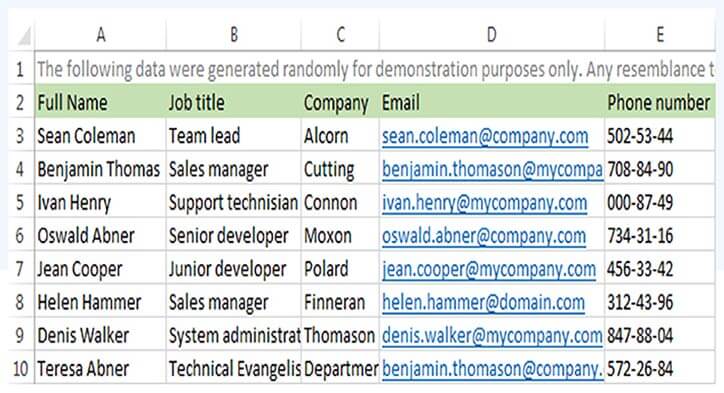
Example: When you have the customer’s phone number, but his email address is missing. This can create a problem when you need to send any campaigns through email. Somebody filling out a survey form can miss a few questions leading to incomplete data. To send personalized mails to the client, companies often look for information on client sentiment data, and if that is missing, the data may not work.
Solution: Use technology to scan your CRM for missing data. Automatically capture valuable missing information to create a better pipeline. Use data enrichment techniques to capture additional information like demographic, firmographics, chronographic, technographic, behavioral, social media, intent, market intelligence, etc. for accurate targeting. Data harvesting using scrapers and crawlers works effectively to capture additional data. Multi-sourced data acquisition helps keep data comprehensive and all-inclusive.
Inaccurate data is created when, despite capturing data correctly, you end up with fake or wrong data. It is the biggest challenge for B2B data aggregators, as often data collected even from most authentic sources can be incorrect and need validation. Data authentication of private and small companies is more challenging, as they are often not listed.
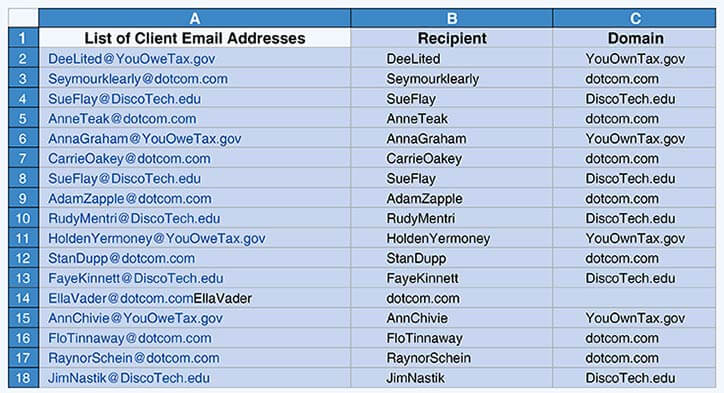
Example: When a prospect enters a fake or wrong mobile number. When a company has changed its location, or a contact person has changed organization.
Solution: Constant data verification and validation is a key step to weed out inaccuracies from the database. Multi-layered verification processes and technology-enabled checks help in maintaining data accuracy. Rule-based macros and bots make the validation process effective. It is also important to check data at the entry point itself. Automated real-time data capture platforms provide a comprehensive solution for this problem.
Web research and other data sources are used to identify irrelevant, invalid, or obsolete data. Manual, as well as rule-based validation, is used for real-time data validation. And constant monitoring mechanisms are a must keep the data accurate all the time.
Data captured from multiple sources and formats needs to be standardized for easy integration with the target database. Inconsistent data doesn’t adhere to predefined rules and can be non-standardized. If, after all the drills of data collection, verification, validation, and enrichment, the data is not made consistent, it will not be of much use.
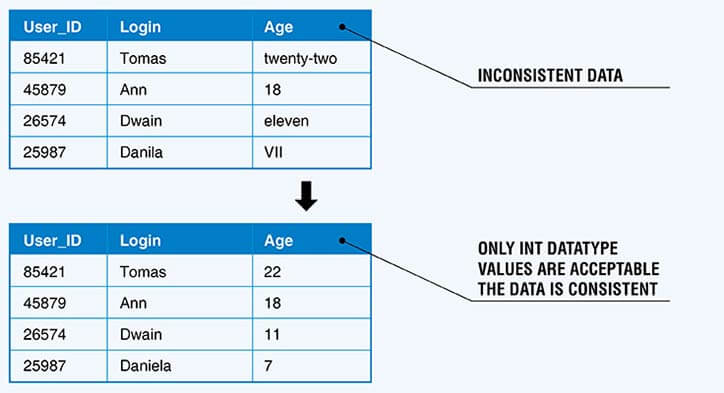
Example: For instance, the CMO, Chief of Marketing, and Chief Marketing Officer are all versions of the same data field, but entered in different formats.
Solution: Create a standard file-naming convention. Standardize and normalize format for data consistency. Have a well-planned data integration system where data from different sources are standardized, providing the user with a unified view of the data.
Managing dirty data is a complex process. It requires constant monitoring, identification of problems, and finding appropriate solutions. You need to have a well-planned system in place for database cleaning. Data can be cleaned using applications like Excel, Google sheets, MySQL or PostgreSQL, MongoDB, any data server, platform, or software like Tableau. Though the rules may vary according to application, the core targets and techniques of data cleaning remain the same.
Data cleaning tools are used to correct data errors and improve the quality of data used in applications. These tools are used to organize, clean, structure, and enrich data. Here are the top 7 data cleaning tools:
Each of these tools has its own strengths and weaknesses and the choice of tool depends on the size and complexity of the data, the skills of the users, and the specific requirements of the data cleaning task.
The future of data cleaning will be characterized by the increasing use of artificial intelligence (AI) and machine learning (ML) technologies. These technologies will power automated and efficient bulk cleaning of data, handling data volumes much higher than what humans can manage.
Robotic Process Automation (RPA) and AI solutions based on ML will be leveraged to deliver clean, standardized, and accurate data output at high speed and scale. All repetitive and logic-based tasks, such as data acquisition, cleansing, validating, de-duplicating, integrating, and others will now be automated.
With the explosion of data from IoT devices and other sources, the need for scalable and efficient data cleaning solutions will become even more pressing, making it a key area of focus for businesses and organizations. As a result, data cleaning solutions that prioritize privacy, security, and accuracy will see increased demand.
At Hitech BPO, our teams have decades of experience in providing reliable data cleaning services for global B2B data aggregators. We help clients drive a data culture based on quality by providing accurate and affordable solutions to combine and clean their data. We have dedicated data cleansing teams run by veteran data scientists, who can handle a wide range of B2B data challenges.
Our data professionals have expertise in B2B data quality, and the need to clean and manage it for you to make efficient and effective business decisions. With an excellent track record of over two decades in running data cleaning projects of different magnitudes, our data cleansing team can help you get your data updated and back on track quickly!
Investing in B2B data cleansing solutions is a must for every B2B business maintaining large data sets. Data cleansing is a complex process involving multiple tasks such as checking for accuracy, removing invalid and duplicate data, adding in missing values, enriching the data with important qualifiers, and finally standardizing the data to make it consistent.
Considering the huge volumes of data most businesses have to manage, traditional and manual processes are not feasible. Data aggregators should either invest in the right technology, infrastructure, automation, and AI or hire specialized data cleansing companies to do the job.
With data cleansing processes improving every day, keeping up with the ever changing technology can be a tough job for data aggregators. Remember this is a specialized field, and whenever possible it is best to use experts such as the team at Hitech BPO for your organizational data cleansing to save you time and money.
What’s next? Message us a brief description of your project.
Our experts will review and get back to you within one business day with free consultation for successful implementation.
Disclaimer:
HitechDigital Solutions LLP and Hitech BPO will never ask for money or commission to offer jobs or projects. In the event you are contacted by any person with job offer in our companies, please reach out to us at info@hitechbpo.com
Leave a Reply